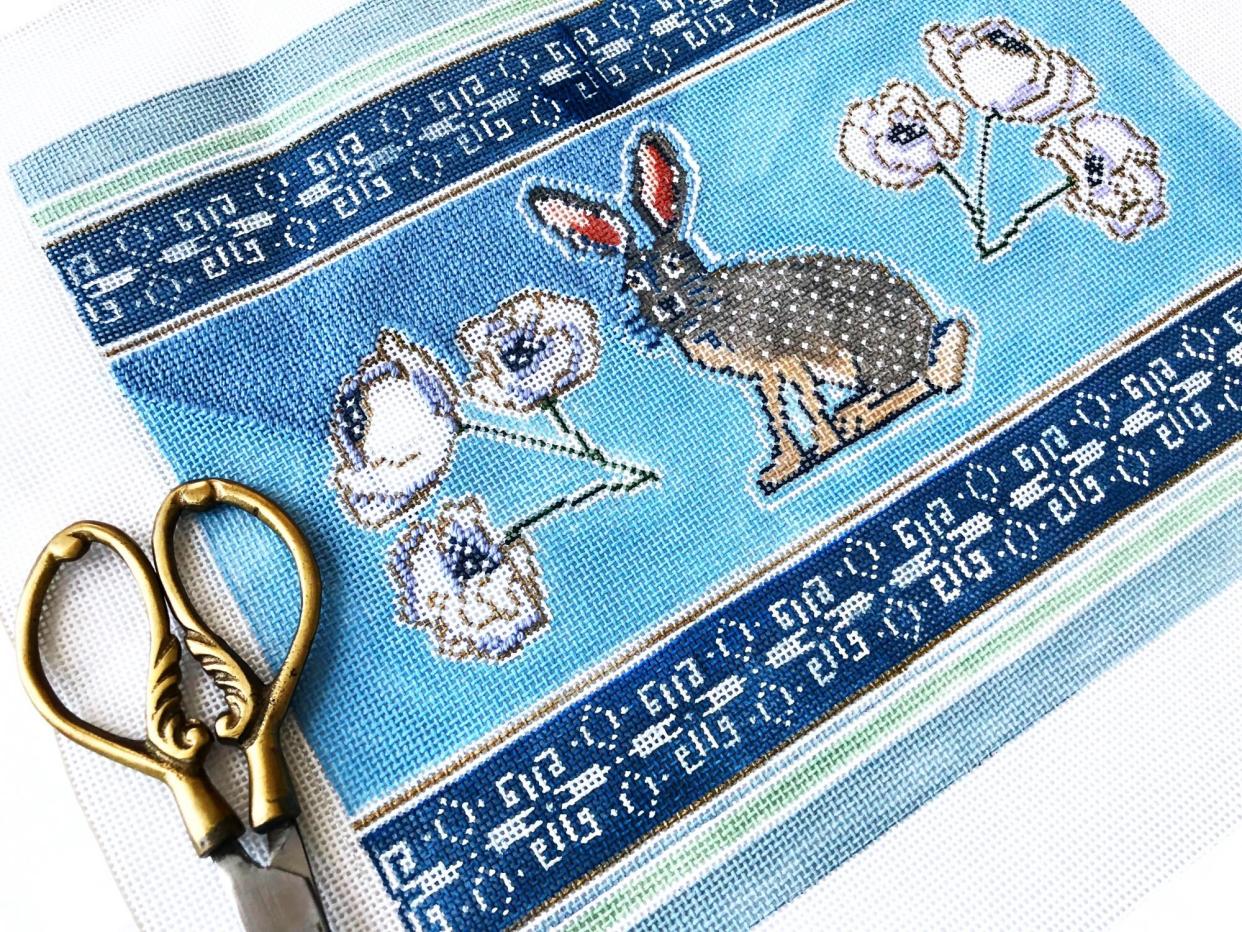The Essential Guide to Needlepoint

Brooke Thorn McGowan
The art of needlepoint has been around for decades, but in recent years, it's attracted the attention of younger generations. If you're looking for a way to reduce your screen time and fill your free time with a therapeutic hobby, needlepoint might be right for you. It's a timeless craft that results in a beautiful, handmade project that you can cherish forever. Each canvas is hand-painted and can be customized for special occasions such as a wedding or holiday. You can turn a fully stitched needlepoint canvas into everything from a Christmas stocking or ornament to a cocktail tray, handbag, or keychain, which puts this craft in a league of its own.
Related: How to Cross Stitch in Embroidery
What Is Needlepoint?
Needlepoint is a type of embroidery that involves passing thread iterations—different materials create different textures—through an open weave mesh canvas. Not to be confused with cross stitch, this style employs a wide array of stitches that result in unique coverage types and durability levels. In fact, it is needlepoint's durability that makes it such a popular embroidery choice for a myriad of household items, including pillows and upholstery.
Choosing a Canvas
Canvases used in needlepoint projects generally range in size from 10 mesh to 18 mesh. The count size refers to how many holes there are per inch; 10 mesh canvas means that there are only 10 holes per inch, so they're much bigger and easier to stitch than 18 mesh canvas, which means that there are 18 small holes per inch. When picking out canvas for your first needlepoint project, we recommend choosing one that is 13 to 14 mesh with a simple design because it will be easier to see the stitch definition more clearly. You can also purchase blank canvas from your local needlepoint shop or on Etsy to practice stitching on, too ($13.99 for 13 mesh, etsy.com).
Choosing the Fibers
Before choosing a colorful array of threads for a canvas, you must decide what type of fiber you want to stitch with—the most common varieties are cotton, silk, wool, and a silk and wool blend. You can also purchase novelty threads, which can be metallic, glow-in-the-dark, or glitter in order to add pizzazz to small areas of a canvas. Your local needlepoint shop will be able to help you choose the best thread for your project. The least expensive variety of fibers are DMC Perle Cotton (from $3.49, michaels.com), and this type of thread, which comes in two sizes, is a great choice for anyone who is new to needlepoint. Size three is intended to work with 13 and 14 mesh canvases and size five works best with 18 mesh canvas. Other popular types of thread are Silk & Ivory ($5.85, theneedlepointer.com), which is a blend of 50 percent silk and 50 percent wool; Planet Earth ($6.45, myneedlepoint.com), which is 100 percent silk that's best for 13 and 14 mesh canvas; and Vineyard Silk ($6.55, theneedlepointer.com), another all-silk thread that's ideal for 18 mesh canvas.
Needlepoint Supplies
In addition to the canvas and fibers, there are a few other notions that will make stitching a breeze. Purchase a good-quality pair of embroidery scissors, which will help you to precisely trim the thread ($10, michaels.com); a travel case to carry the canvas and threads on-the-go; a needle minder, which is a magnetic accessory that holds the needle while you're not using it; a container to organize your soon-to-be growing stash of fibers, such as The Container Store's 36-Compartment Clear Box ($10.99, thecontainerstore.com); and stretcher bars, which will help to prevent the canvas from warping as you stitch it ($9, needlepoint.com). Many needlepoint shops will provide you with the right size tapestry needles for your project. Generally, you should use a size 20 tapestry needle on canvases that are 12 to 14 mesh and a size 22 tapestry needle on canvases that are 14 to 18 mesh.
How to Needlepoint
There are dozens of needlepoint stitches to choose from, but the most basic and versatile are continental and basketweave. If you look closely, mono needlepoint canvases (which means single weave) are made up of a series of small square grids. When stitching, the needle comes up from the bottom left square and crosses over to the top right square. If you're stitching continental, you'll repeat this pattern in a horizontal direction. Basketweave is aptly named because of the woven patten that forms on the back of the canvas; basketweave should be stitched in diagonal rows, starting at the top right-hand section of the canvas and following the "steps" and "poles" of the canvas. While continental and basketweave look similar on the front, basketweave stitch is less likely to cause the canvas to warp.
Finishing the Canvas
One of the biggest questions when it comes to needlepoint is what to do with the canvas. From pillows to wall-hangings, the possibilities are truly endless when it comes to turning the canvas into something you can display in your home. The best way to finish a needlepoint canvas is to bring it to a local needlepoint shop. You can leave the final design up to the experts or choose all of the details—such as the fabric for the back of a pillow or the trim for an ornament—yourself.
Where to Buy Needlepoint Canvases
Why is needlepoint so expensive? Most needlepoint canvases are hand-painted, so you're literally paying for a piece of art (most canvases will start around $50 and can easily reach $400, depending on the size and intricacy of the design). The paint on the canvas indicates exactly where to stitch each color. There are plenty of modern needlepoint designers, such as Lycette Designs, Thörn Alexander, Pip and Roo Needleworks, and Morgan Julia Designs, that sell their hand-painted needlepoint canvases online.

